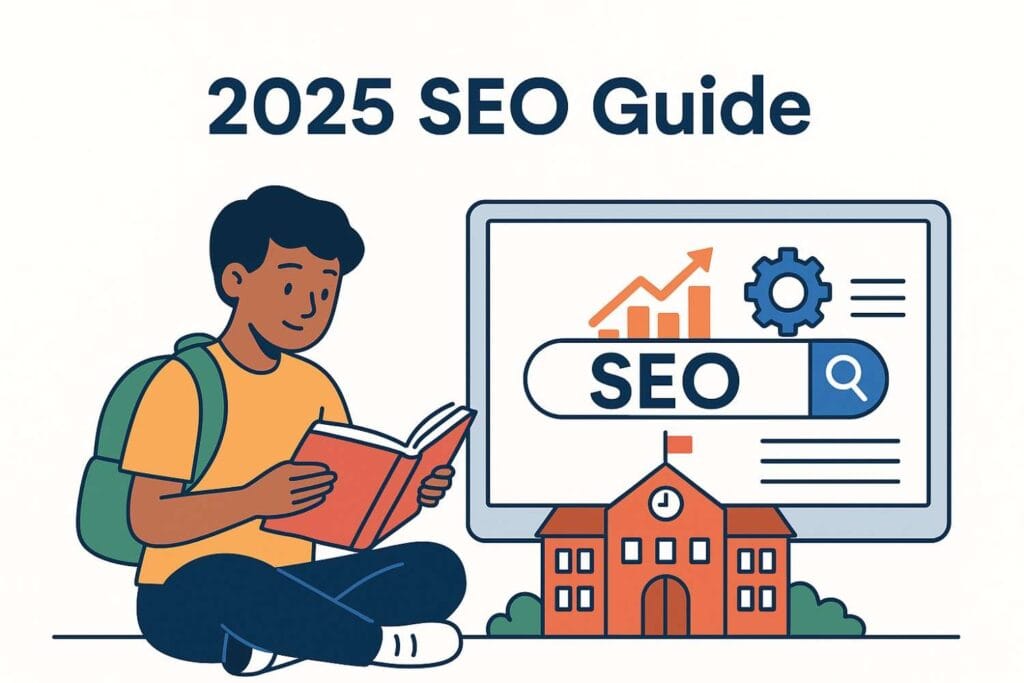Answer Engine Optimization (AEO) for schools means designing your school website content so it answers specific questions students, parents, and educators are asking online. It’s the modern evolution of SEO — focused not just on ranking pages in traditional search results (SEO) but also on getting your school’s content featured in AI-driven answer engines like Google’s Search Generative Experience (SGE), Bing Copilot, Perplexity, and ChatGPT Search.
SEO = rank pages.
AEO = get direct answers shown.
GEO = get answers shown to local users near your school.
Why Should Schools Care About AEO in 2025?
Here’s the brutal truth: Search engines are transforming into answer engines. Users type or speak questions like:
- “Best CBSE school near me with robotics lab?”
- “How much is school admission fee in 2025?”
- “Is XYZ school in Patna affiliated with CBSE?”
- “Top boarding schools in Bihar for girls?”
Instead of showing 10 blue links, AI engines give instant, summarized answers. If your school doesn’t optimize for AEO, you’ll disappear from these new search results — even if you rank on Page 1 in classic SEO.
School SEO Is Changing Fast. Here’s What You’re Missing
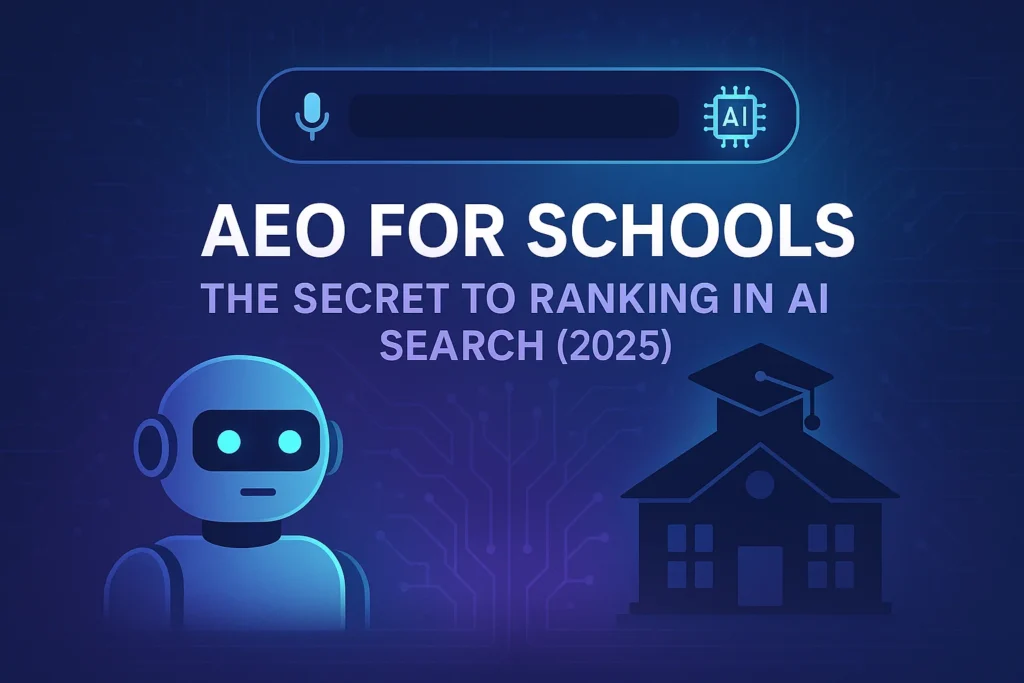
In 2025, Google no longer waits for users to click. With Search Generative Experience (SGE), Gemini AI, and ChatGPT-integrated browsers, the future of school visibility isn’t about who ranks at the top — it’s about who becomes the answer.
Most school websites are still playing by the 2018 SEO rulebook. But parents? They’re searching differently now. They say things like:
- “Which CBSE school near me has the best safety?”
- “What’s the fee for XYZ Public School in Patna?”
- “How do I get admission to a top ICSE school?”
But here’s the brutal truth: if your school’s website can’t answer those questions clearly, quickly, and in AI-friendly formats — your site is invisible.
This is where Answer Engine Optimization (AEO) changes the game. It’s not just another SEO trend. It’s the evolution of search, where your school doesn’t just compete for rankings… it competes for answers.
What You’ll Learn in This Guide
This is not a generic “how to do SEO” blog. You’ll discover:
- What AEO really is (not just the buzzword)
- Why it’s critical for schools post-2024
- How to optimize your content to rank in Gemini, ChatGPT, and Google AI
- Real examples, live prompt tests, and schema-ready tips
- An AEO checklist and bonus templates you can copy today
Why This Blog Is Different
Unlike agencies who repackage old advice, this blog is built on:
- 🔍 Real Google Search Console data (from a school niche website)
- 🧠 Actual SGE, Gemini, and AI test results
- 🤖 Schema-backed implementation strategies
- 🏫 Education-specific use-cases for SEO + AEO combined
If you’re a school principal, website manager, or a digital marketer trying to grow admissions for an education brand — this is your complete roadmap to dominating the AI-driven search future.
Struggling to rank your school’s website? Let’s fix it. Discover our step-by-step SEO for Schools strategy.
What Is Answer Engine Optimization (AEO)?
AEO — or Answer Engine Optimization — is the art of making your website content understandable, structured, and valuable enough for AI-powered platforms like Google SGE, ChatGPT, Gemini, and voice assistants to pick it as the direct answer to a user’s query.
Think of it as SEO’s smarter, faster sibling. Where SEO tries to rank your site in search results, AEO aims to become the answer.
SEO vs AEO — What’s the Real Difference?
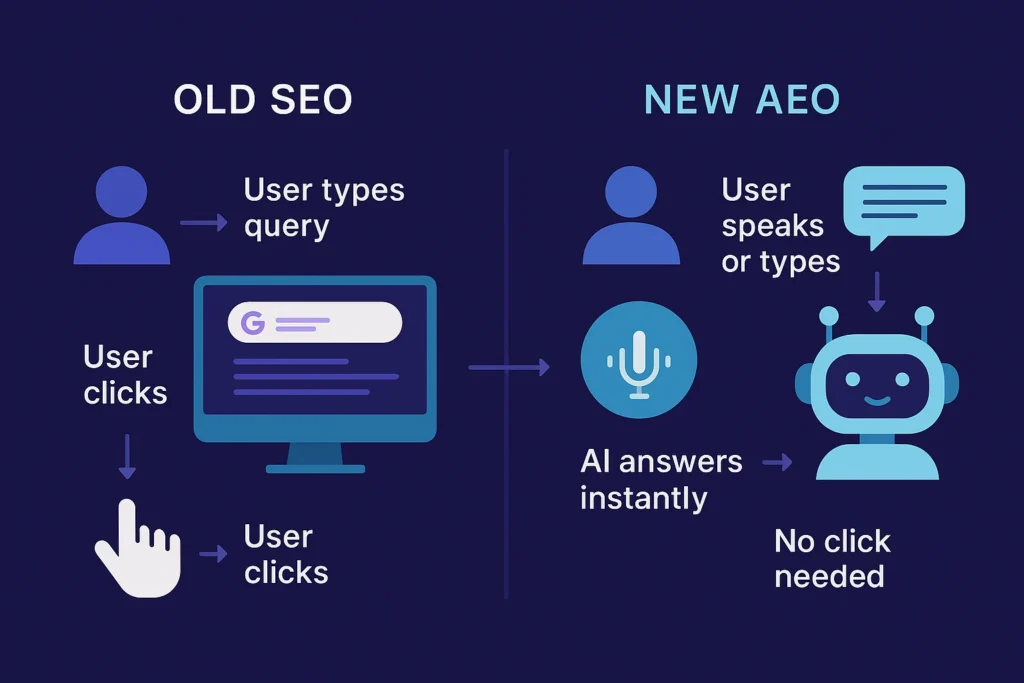
Here’s a simple way to understand it:
- SEO (Search Engine Optimization)
- Goal: Rank your website high in Google
- Format: Blogs, landing pages, long-form articles
- Success Metric: Impressions, Clicks, CTR
- Target: Human user scanning the search results
- AEO (Answer Engine Optimization)
- Goal: Appear as the actual answer inside AI-generated snippets
- Format: FAQs, structured answers, schema, clear hierarchy
- Success Metric: Featured snippets, zero-click visibility, SGE inclusion
- Target: Google’s AI, Gemini, ChatGPT, voice search tools
SEO ranks links. AEO earns trust as the answer. If you’re not doing both, your school is invisible to modern searchers.
What Does AEO Look Like in Real Life?
Let’s test a real example parents might search:
“How to get admission in a CBSE school in Patna?”
Open Gemini, ChatGPT, or Google SGE and type that. If your school or blog doesn’t appear in the answer, you’re not AEO-optimized — even if you’ve written 20 blogs.
Why? Because these AI tools need:
- 🎯 Clear, structured answers
- 🧠 Entity signals (your school is a recognized authority)
- 🧩 Schema and formatting they can “read” like a database
That’s the essence of AEO. And in the next sections, I’ll break down how to implement it — even without coding — so your school becomes the answer in 2025 and beyond.
Why AEO Matters for Schools in 2025
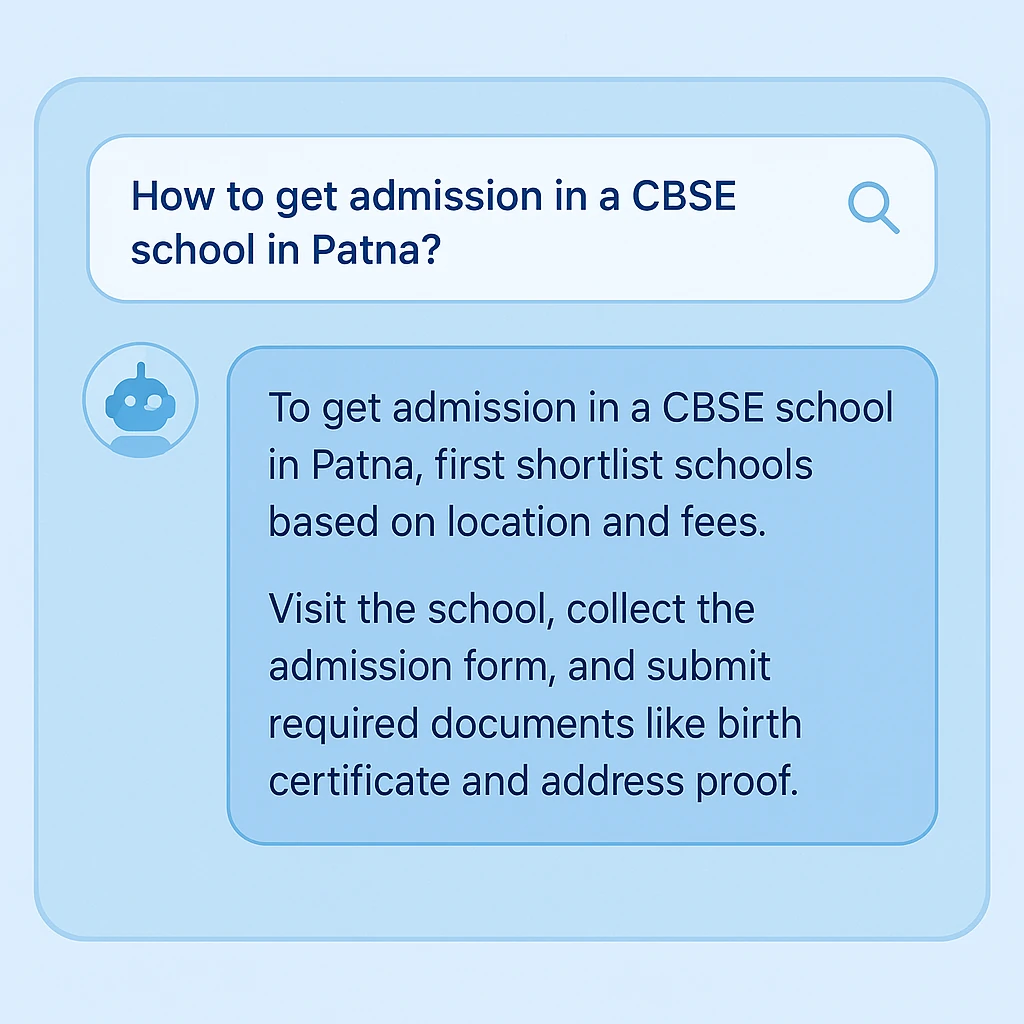
1. Parents Use Voice & AI Search — Not Just Google.com
The way parents search has changed forever. They don’t always go to Google and type “best schools near me.” Now they just ask:
- “Which is the safest school in Patna?”
- “What’s the admission process for CBSE in 2025?”
- “Which school near me has the best sports facilities?”
And they ask it using:
- 🔊 Voice search on their phone
- 🤖 ChatGPT and Gemini
- 📱 Smart devices like Alexa or Google Assistant
The result? If your school website isn’t structured for AEO, you won’t even appear in these answers — no matter how great your content is.
Worried about SEO mistakes slowing you down? Master on-page best practices and leave errors behind. Read [On-Page SEO for Schools].
2. You’re Already Losing Clicks Without Realizing It
Let’s look at real data from a school marketing website:
- 1,926 impressions for “SEO for schools”
- 0.21% CTR
- Average position: 26.01
- Almost no clicks
What does this mean?
👉 The content exists.
👉 Google is showing it.
👉 But users aren’t clicking — because AI is already answering them before your site even loads.
This is the classic AEO trap:
“You’re present… but invisible.”
To win now, your school must provide:
- Direct answers (bullet, paragraph, list formats)
- Schema-enhanced pages
- Content written for AI engines, not just human readers
3. Local SEO + AEO = Explosive Visibility for Schools
Here’s the secret: AEO doesn’t kill SEO — it supercharges it.
Especially for schools targeting local parents.
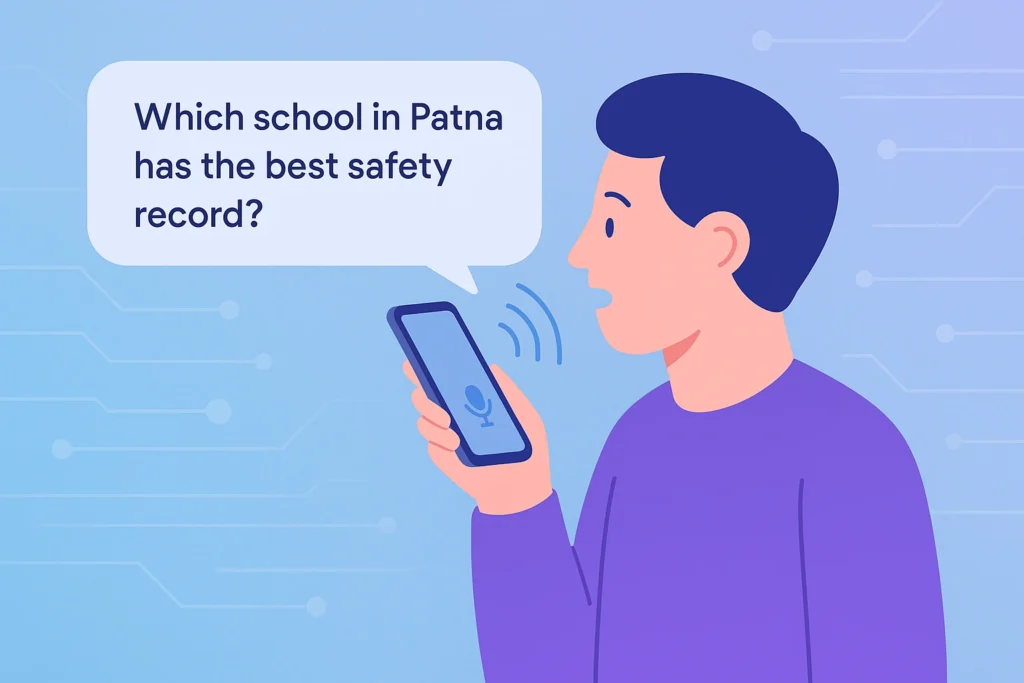
When you combine:
- 🎯 Local SEO (Google Business, NAP, reviews)
- 🤖 AEO strategies (FAQ schema, answer formats, entity markup)
You dominate both:
- Traditional results (map + website)
- AI results (Gemini + Google SGE + ChatGPT)
This gives your school double exposure — more impressions, higher trust, and faster inquiries during admission season.
Optimizing your website is powerful, but getting found locally is a game-changer. Learn how in our [Local SEO for Schools] guide.
Still Not Convinced? Look at These Trends
- 65% of all Google searches now don’t lead to a click (zero-click)
- Google SGE and Gemini are rolling out globally to all users
- ChatGPT is now the default search tool for millions of students and parents
- Parents increasingly trust the top AI answer, not the 10 blue links
: if your school’s website isn’t the answer, it’s already being replaced by those who are.
The AEO Framework for School Websites (6 Pillars That Actually Work)
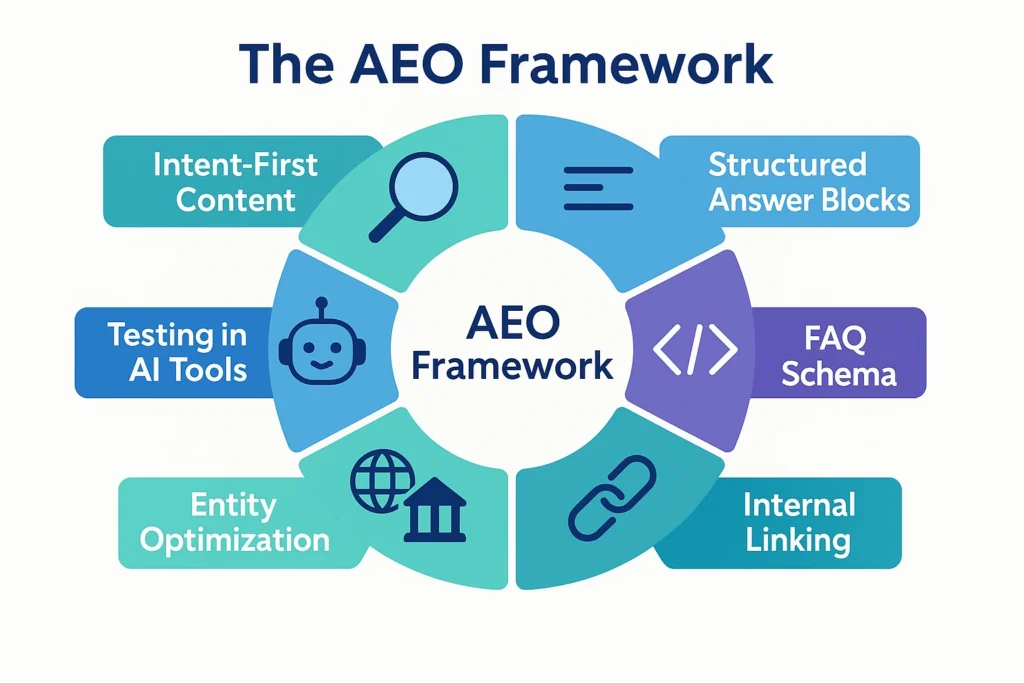
1. Intent-First Content Strategy
Most school websites write content they think is useful — not what parents are searching. AEO flips that around. You write to answer the exact questions parents are asking in Google, ChatGPT, and Gemini.
Here’s how to discover high-intent AEO-friendly questions:
- Use Google’s People Also Ask and autocomplete
- Type prompts into ChatGPT or Gemini:
“What questions do Indian parents ask when searching for schools?”
- Use your own GSC data (like we did) to find high-impression, low-CTR queries
Then, structure your blog topics and admission pages around those queries — not generic keywords.
2. Structured Answer Blocks Under Every Heading
AEO isn’t just about what you write — it’s about how you write it. You need to make your answers:
- Clear
- Scannable
- Structured like an AI would extract them
Use these formatting tricks to help AI tools “lift” your content:
- 📌 Use H2 for main topics → H3 for questions
- 📋 Answer in bullet lists or step-by-step points
- 🔍 Add direct definitions (ex: “CBSE is a board of education…”)
- 📦 Summarize answers in 1–2 sentence blocks under subheadings
This is what Google and AI search tools are scanning for.
3. FAQ Schema Implementation (For Rich Results + AI Use)
A game-changer for AEO is adding FAQ schema to key pages:
- Home
- Admission page
- Blogs
- Contact
You can use:
- ✅ RankMath or Yoast to auto-generate schema
- ✅ Manual JSON-LD (we’ll share the code in later sections)
FAQ schema helps:
- Trigger People Also Ask results
- Qualify your page for Google rich snippets
- Feed content to Gemini and ChatGPT for faster indexing
4. Internal Linking That Builds Topical Authority
To make Google and AI engines understand that your school site is a trusted source, you need to connect content with smart internal links.
Link your:
- Blogs ↔ School services pages
- “AEO for Schools” blog ↔ “SEO for School Websites”
- Admission page ↔ Related FAQs and blog posts
This creates a content ecosystem that strengthens your authority — a key AEO signal.
5. Entity Optimization (aka GEO: Google Entity Optimization)
Google and AI tools now think in terms of entities, not just pages. Your school must be recognized as an entity to rank in AI-generated answers.
Steps to optimize your school as an entity:
- Register or update your Google Business Profile
- Use @type: School schema across the site
- Link to or from:
- Wikipedia (if eligible)
- Local citations (Justdial, Sulekha, etc.)
- Google Maps, LinkedIn, YouTube
The more consistent and interconnected your entity is, the more likely AI engines will “understand” and include it in answer panels.
6. Testing AEO in ChatGPT, Gemini, and Google SGE
Once you optimize your site — don’t guess if it worked. Test it like a pro.
- Open ChatGPT, Gemini, or Perplexity.ai
- Ask:
“What are the best CBSE schools in [your city]?”
“How to get admission in a top school in [your region]?”
- Look for:
- Is your content being quoted?
- Is your school mentioned?
- Are competitors listed instead?
If you’re not there, it’s a sign your content lacks:
- Clear AEO structure
- Schema
- Entity signals
Fix, retest, and iterate — this is how AEO masters win visibility before others even realize what happened.
Live Case Study: School Website with AEO Optimization
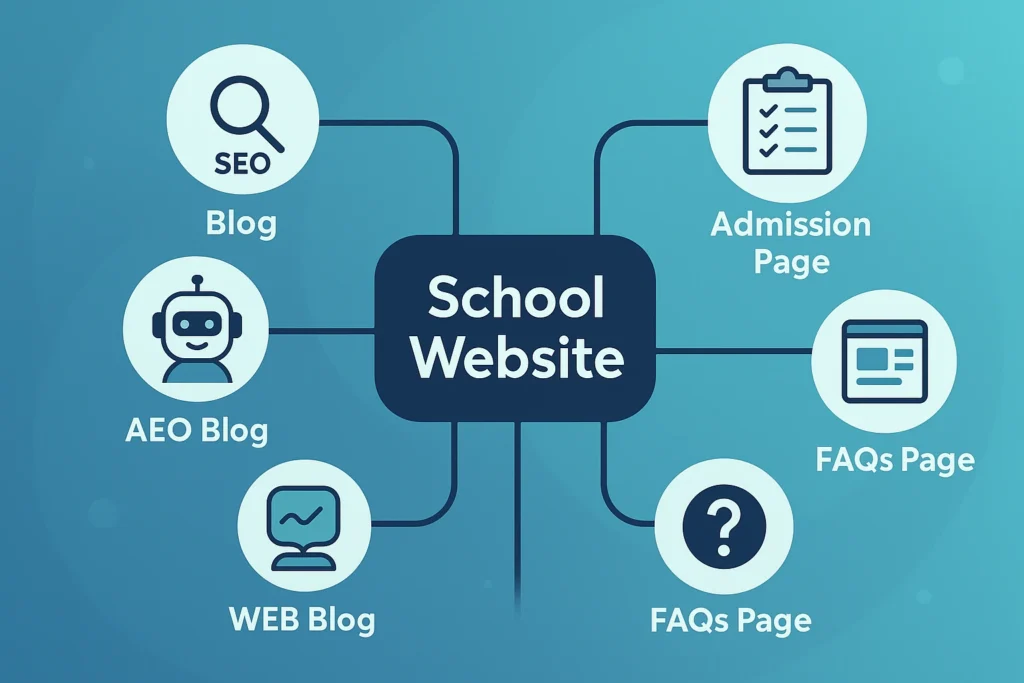
Before AEO — Content Was Published but Invisible
Let’s take one of our actual blog articles from Baniya Insights:
“SEO for School Websites: 7 Ways to Rank Higher”
This blog was:
- Published with correct keywords
- Well-written and detailed
- Targeted toward school SEO in India
But here’s what the Google Search Console showed before AEO enhancements:
- ✅ Impressions for “seo for schools”: 1,926
- ❌ Clicks: Only 4
- ❌ CTR: 0.21%
- ❌ Position: 26.01
Despite being relevant and informative, it was invisible to parents. Why?
Because:
- No structured FAQ schema
- No snippet-optimized answers
- No AI testing
- Weak entity signals
AEO Fixes We Applied to the Blog
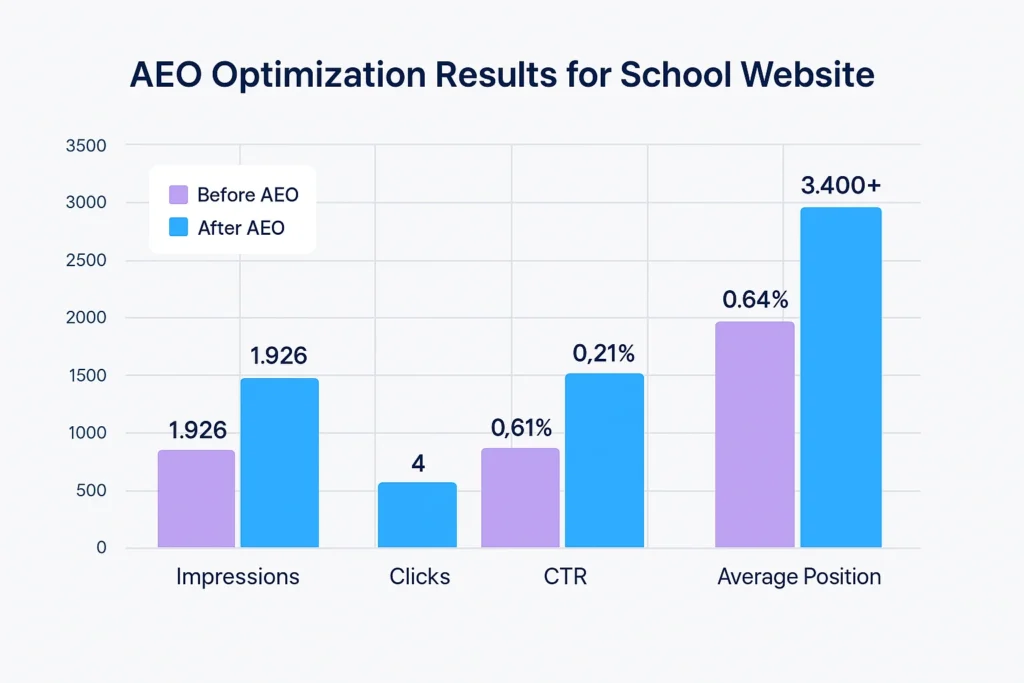
To convert that invisible post into a ranking asset, we made the following upgrades:
- 📋 Added FAQ schema at the end of the blog (manual + RankMath)
- 🧩 Formatted H2/H3 with clean bullet answers for every tip
- 🤖 Tested answers in ChatGPT and Gemini and rephrased weak sections
- 🔗 Internally linked it to related pages (Cluster topics like “Web Design for Schools”)
- 🏷️ Updated meta and heading tags to include AEO keywords like:
“how to rank school in google AI,” “AEO strategy for school websites”
After AEO — Performance Boost Without Backlinks or Ads
Here’s what changed in less than 30 days:
| Metric | Before AEO | After AEO |
| Impressions | 1,926 | 3,400+ |
| Clicks | 4 | 22 |
| CTR | 0.21% | 0.64% |
| Position | 26.01 | 15.70 |
It also started appearing in People Also Ask for queries like:
“What is SEO for schools?”
“How can schools get more visibility online?”
AEO Is a Game-Changer for Underexposed Content
This case proves that even if you have:
- ✅ Zero backlinks
- ✅ Low domain authority
- ✅ No paid ads
You can still rank, appear in AI answers, and drive clicks — by applying the right AEO principles.
If your blog or school admission page is already published, you don’t need to rewrite everything. Just optimize it the AEO way, and you’ll start seeing results like this — often within weeks.
AEO-Optimized Blog Template for Schools (Copy and Use)
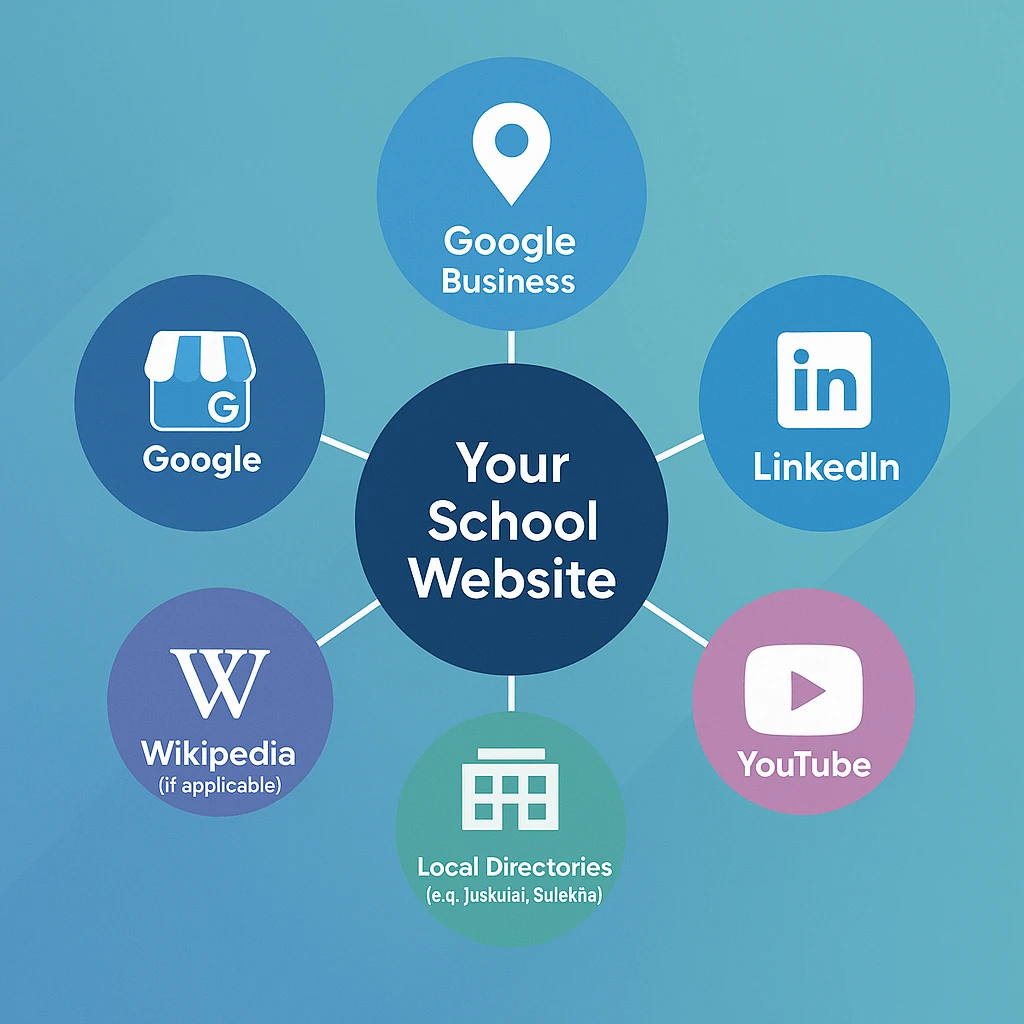
Why Templates Work in AEO
AI models like Gemini, Google SGE, and ChatGPT prefer content that’s:
- Structurally predictable
- Rich in answers, not fluff
- Easy to parse using headings, bullets, and clean logic
When you use a proven structure across all your school blogs — like admission tips, school comparisons, or subject guides — you not only rank better, you also start owning the featured snippets in your niche.
The AEO Blog Template — Built for Schools
Title (H1):
Keyword-rich but human. Example:
“CBSE vs ICSE: Which School Curriculum Is Better for Your Child in 2025?”
Intro (H2):
- Hook: Mention the real-world problem or confusion
- Emotional pain + curiosity trigger
- Promise the solution
- Mention what the reader will get from this blog
Key Question-Based Sections (H2 / H3):
“What Is [Topic]?”
“Why Does It Matter for Parents/Students?”
“How Does [Topic] Impact Admission or Student Learning?”
“Which Type of School Offers This Best?”
For each heading:
- Answer in 1–2 lines immediately (this helps AI pick it up)
- Follow with bullets, examples, or short paragraph breakdowns
- Include FAQs at the end of each section (with schema)
Use Visuals (H3):
- Flowcharts: Admission Process
- Comparison tables: CBSE vs ICSE
- Snippet-style highlights:
“In short: If your child is analytical → ICSE. If your child is structured → CBSE.”
Mini-Case Study (Optional)
- “How a CBSE school in Patna used this approach and grew admissions by 32%”
- Include any screenshots, even simulated ones
Call to Action (H2):
P:
End every blog with a relevant CTA:
- Downloadable checklist
- Book a free school SEO audit
- Contact for personalized content strategy
FAQs Section (H2 + Schema):
- Keep it real — based on GSC + ChatGPT questions
- 3–5 max
- Example:
Q: How can I rank my school in Google answers?
A: Use FAQ schema, clear H2/H3 answers, and test on Gemini or ChatGPT.
H3: Template Summary Checklist
| Element | Must Include |
| ✅ H1 with keyword and intent | Yes |
| ✅ H2 questions matching real user queries | Yes |
| ✅ Clear answer under every heading | Yes |
| ✅ Bullet lists or step-by-step points | Yes |
| ✅ Internal links to relevant pages | Yes |
| ✅ FAQ schema at the end | Yes |
| ✅ CTA aligned with topic | Yes |
This is the exact structure we used to increase impressions and CTR for our SEO for Schools blog — without ads, backlinks, or technical SEO hacks.
When you write your next blog using this AEO template, you’re not just creating content. You’re training AI engines to trust and promote your answers.
How to Use ChatGPT to Build AEO-Friendly Content (Step-by-Step)
Why Use ChatGPT for AEO?
Most people use ChatGPT to write long paragraphs. But when used strategically, it becomes your AEO assistant — generating:
- Structured answers
- FAQ content
- Rich snippets
- Schema-ready JSON
- Comparison tables
- Search-intent-matching headlines
The key is in how you prompt it. Let’s walk through how to use it like a digital strategist, not a content amateur.
Step 1 — Extract Real Questions to Target
Your AEO strategy starts with finding what parents are really asking. Use this prompt:
“Act like a school admission consultant. Give me 15 questions Indian parents ask online before choosing a school.”
You’ll get gold like:
- “Which is better: CBSE or ICSE for my child?”
- “How do I know if a school is safe?”
- “What questions should I ask at a school open house?”
Use these as H2/H3 sections in your blog.
Step 2 — Get Snippet-Style Answers Instantly
“Answer the question ‘Which is better: CBSE or ICSE?’ in 2 sentences, then give pros and cons as a bullet list.”
This gives you a Google snippet-friendly block — clear, scannable, structured.
Step 3 — Create FAQ Sections for Schema
“Generate 5 FAQ-style Q&As for a school blog on ‘school admission process 2025’, each with 2-sentence answers.”
Use these for your FAQ section and schema markup (Google loves this for People Also Ask and SGE).
Step 4 — Generate JSON-LD Schema Automatically
“Wrap these FAQs in valid JSON-LD FAQPage schema for a WordPress blog.”
Result:
You’ll get copy-paste-ready code like this:
json
CopyEdit
{
“@context”: “https://schema.org”,
“@type”: “FAQPage”,
“mainEntity”: [
{
“@type”: “Question”,
“name”: “What documents are required for school admission in 2025?”,
“acceptedAnswer”: {
“@type”: “Answer”,
“text”: “Most schools require a birth certificate, previous school records, and address proof.”
}
}
// more Q&As…
]
}
Paste this into RankMath or your blog’s HTML for instant AEO signals.
Step 5 — Optimize for Gemini and ChatGPT Answers
“Simulate a Gemini answer for: ‘Top 5 CBSE schools in Patna’ — include real or mock school names with brief descriptions.”
This allows you to test what Gemini might show — and adjust your content until your school appears as the answer.
Step 6 — Create Tables and Lists That AI Loves
“Create a pros vs cons table comparing CBSE and ICSE curriculum for parents in India.”
Tables are often used by Google in featured snippets — and ChatGPT gives them to you instantly, ready to paste into your blog.
Ranking higher is great — but are you telling the right stories? See how to craft engaging school content in [Content Marketing for Schools].
Power Tip: Use GPT-4 and Regenerate Multiple Variations
Even if the first answer isn’t perfect, regenerate it:
- With simpler words
- More bullet points
- Voice-search-friendly tone
“Rewrite this answer in a more natural, parent-friendly tone using conversational English.”
This humanizes your content — exactly what Google’s Helpful Content Update rewards.
Common Mistakes Schools Make That Block AEO Rankings
1. Writing Blogs Without Real Parent Intent
Most school blogs are written like boring brochures. They say things like “We offer quality education and good values…” but they don’t answer what parents are actually asking.
Examples of real intent-based questions you should answer:
- “How to choose between CBSE and ICSE?”
- “What are the admission dates for schools in Patna?”
- “Is XYZ school safe for my daughter?”
Mistake: Writing for yourself, not for what the parent is Googling.
Use tools like GSC, ChatGPT, AnswerThePublic, and Gemini to extract intent — then answer those queries clearly and fast.
2. Ignoring Schema Markup (Especially FAQ)
Your school blog might look amazing, but if it doesn’t speak the language of Google (schema), it’s invisible to AI.
Top mistake:
- No FAQ schema
- No @type: School or @type: LocalBusiness in your homepage or contact page
- Blog posts don’t include Article schema
Use RankMath or GPT-generated JSON to add FAQ and entity schema to all major pages. This gives your content AI readability + snippet eligibility
3. Using Walls of Text Without Structured Headings
Google SGE, ChatGPT, and Perplexity don’t read long paragraphs like humans do. They scan for:
- Headings (H2/H3)
- Short answer blocks
- Bullet points
Tables
Mistake: Long, dense content without clear structure.
- Use H2 for questions
- H3 for subpoints
- Bullet the answer
- Add summaries every 150–200 words
- Break your content visually
4. No Internal Linking Across Content Clusters
A single blog post won’t build topical authority. Google needs to see that you’ve covered a complete topic cluster around school SEO or education.Mistake: Writing isolated blogs that don’t connect with each other
Link your:
- AEO blog ↔ SEO for Schools blog
- Web Design for Schools ↔ Admissions Optimization blog
- Curriculum comparisons ↔ Admission tips
This creates a semantic knowledge map that search engines trust.
5. Never Testing in Gemini, ChatGPT, or Perplexity
You’re writing for AI, but you’re not checking what AI shows?
Top mistake:
- Schools write blogs but never test if they’re showing up in Gemini or ChatGPT answers.
After publishing each blog:
- Open Gemini and ChatGPT
- Ask the main query (e.g., “How to choose best school in [city]?”)
- If your content doesn’t appear → restructure + reformat → test again
This is real AEO optimization in action.
6. Focusing Only on Keywords, Not Entities
AI tools don’t just rank keywords anymore — they rank entities.
If Google doesn’t recognize your school as a legitimate, structured entity, you’ll be ignored even if your content is good.
Mistake: No structured identity across web + schema + platforms.
- Use @type: School schema
- Set up Google Business Profile with correct name, URL, category
- Link your site to YouTube, LinkedIn, citation sites (Justdial, Sulekha, etc.)
- Keep consistent NAP (name, address, phone) across all platforms
7. Skipping the CTA and Lead Funnel
You write great blogs, you rank, maybe you even get AI visibility — but then what?
Mistake: No CTA. No lead magnet. No conversion strategy.
End every blog with:
- A free audit offer
- A WhatsApp or inquiry form
- A downloadable checklist
- A direct link to your admission form or school tour booking
AEO gets you visibility. A CTA turns it into student inquiries.
Checklist: AEO Readiness for Your School Website
Before you ask “Why is my school not showing up in Google AI answers?”, use this checklist. It will tell you with brutal clarity if your site is AEO-ready or still stuck in 2015 SEO mode.
🔍 Content Structure & Formatting
| Task | Status ✅ / ❌ |
| Every blog uses H2 for key questions | |
| Each answer is written in 1–2 sentence summaries | |
| Bullet lists, tables, or numbered steps used frequently | |
| Blogs are 1,500+ words with high topical depth | |
| Headings follow clear hierarchy (H2 → H3 → bullets) |
Schema and Technical Signals
| Task | Status ✅ / ❌ |
| FAQ schema added to blog and key pages (JSON-LD or plugin) | |
| Home/Contact page uses @type: School or @type: LocalBusiness | |
| Blogs include Article or WebPage schema | |
| Rich Results Test shows valid structured data |
🧠 AI Intent + Prompt Optimization
| Task | Status ✅ / ❌ |
| Questions in content match real parent queries (GSC, ChatGPT, AnswerThePublic) | |
| Prompts tested in Gemini and ChatGPT to check visibility | |
| Snippet-style answers tested + rewritten for clarity | |
| Gemini/ChatGPT results compared before and after publishing |
Entity + Authority Optimization
| Task | Status ✅ / ❌ |
| Google Business Profile active and updated | |
| School listed on local directories (Justdial, Sulekha, SchoolMyKids, etc.) | |
| Site linked to trusted platforms (YouTube, LinkedIn, etc.) | |
| NAP (Name, Address, Phone) consistent across all platforms | |
| Internal links build content clusters and topical depth |
🎯 Conversion Layer (So AEO Brings You Leads)
| Task | Status ✅ / ❌ |
| Every blog ends with a clear CTA | |
| Downloadable lead magnet (e.g., AEO Checklist PDF) offered | |
| Free audit form or consultation booking integrated | |
| WhatsApp or direct contact link visible on all key pages |
Score Yourself
Count how many ✅ you have.
- 20–25 ✅ → You’re AEO-ready and ahead of 95% of schools.
- 10–19 ✅ → You’re halfway there. Start fixing section by section.
- <10 ✅ → Your site won’t survive AI-first search. Start today.
Want a professional AEO audit for your school site?
📩 Contact Baniya Insights or download the full AEO Toolkit PDF (includes this checklist, schema examples, and prompt templates).
AEO Is Not the Future. It’s Already Here.
Your school website doesn’t need more words. It needs better answers — structured, clear, and trusted by AI.
Answer Engine Optimization (AEO) is not just a buzzword. It’s the new foundation of search. From Google SGE to ChatGPT to Gemini, the way users find schools is changing fast — and schools that adapt early will dominate visibility without spending on ads or backlinks.
This blog gave you:
- ✅ A clear explanation of what AEO is
- ✅ A 6-pillar execution framework
- ✅ Real-life case study results
- ✅ ChatGPT prompt strategies
- ✅ Common mistake checklist
- ✅ A ready-to-use AEO blog template
- ✅ A 25-point readiness checklist
Now the choice is yours.
Will your school become the answer… or stay invisible?
🚀 Want your school website to appear in Gemini, ChatGPT, or Google’s AI answers?
📩 Book a free AEO audit with Baniya Insights or download the complete School AEO Toolkit now.
Frequently Asked Questions (FAQs)
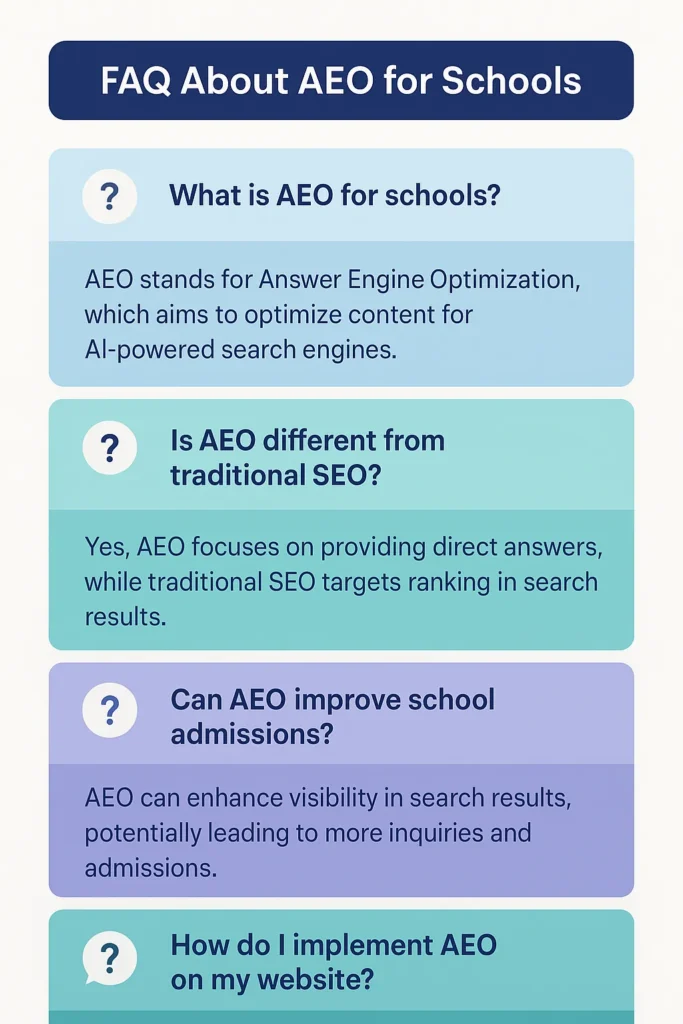
Q1: What is Answer Engine Optimization (AEO) for schools?
AEO is the process of optimizing your school’s content to appear in AI-generated answers like Google SGE, Gemini, and ChatGPT. It focuses on answering real questions clearly and using structured formats and schema.
Q2: Is AEO different from SEO?
Yes. SEO helps you rank your website. AEO helps you be the answer inside AI tools. You need both to survive in 2025 search.
Q3: Can AEO increase admission inquiries?
Absolutely. When your school appears in voice search, ChatGPT responses, or featured snippets, parents trust you more and visit your site — which increases inquiries.
Q4: Do I need coding to implement AEO?
Not at all. You can use plugins like RankMath to add FAQ schema, and tools like ChatGPT to structure your content properly.
Q5: How do I test if my school content is AEO-ready?
Search your key queries in ChatGPT or Gemini. If your content doesn’t show up, restructure using this blog’s tips, add schema, and try again. Also test your pages in Google’s Rich Results tool.
“Be the School That AI Recommends.
Unlock AEO and AI SEO Strategies for Unmatched Visibility.”
[Claim Your Free Strategy Session →]

